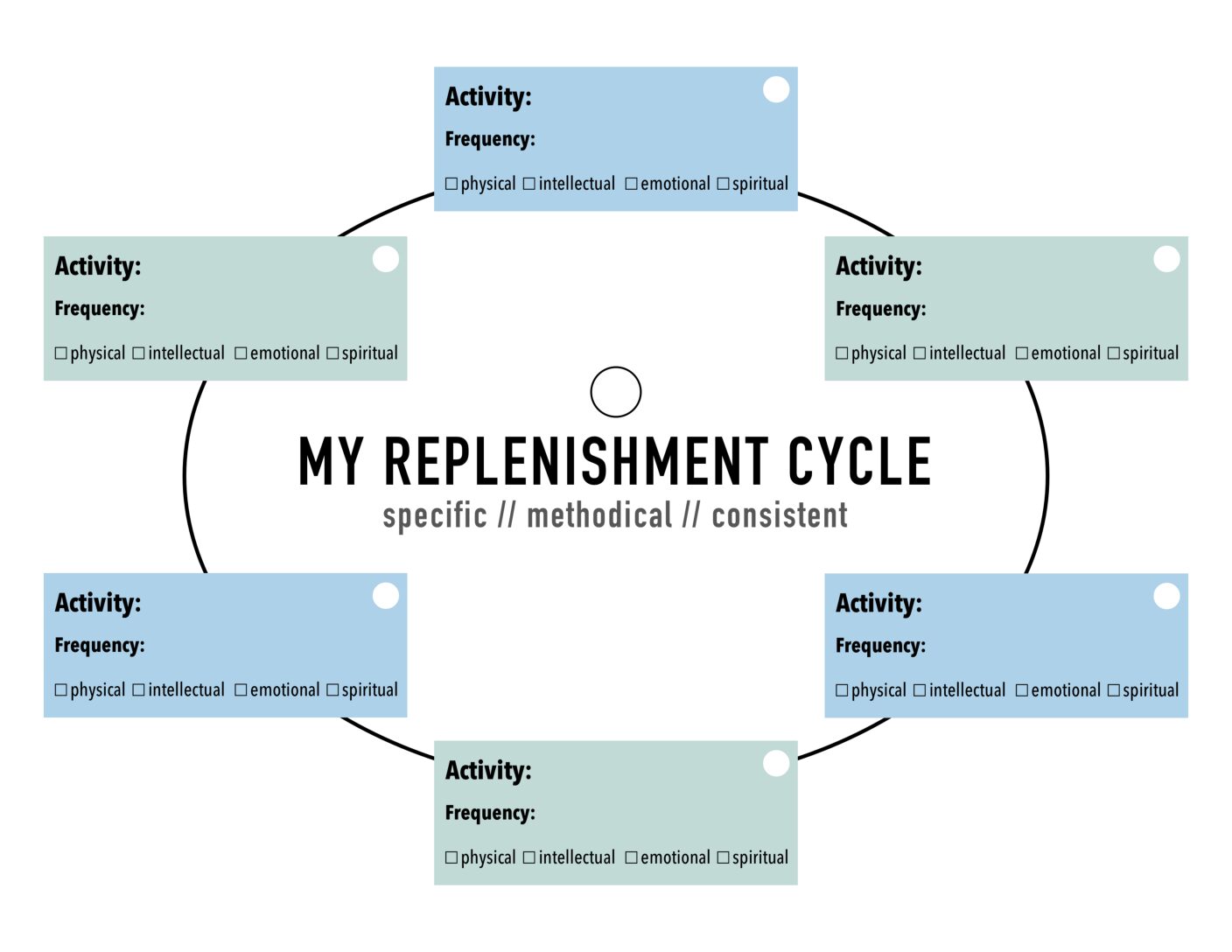Replenishment Cycle
The Replenishment Cycle is a tool to help us think through the activities or practices that refuel us, evaluate how we are currently doing at those things, and make a plan that we can hold ourselves accountable to! Replenishment is different than “turning yourself off” — watching TV for three hours might feel restful after a long week, but it’s not actually helping fill you back up. Replenishing habits sometimes actually feel like another thing to do (exercise, anyone?), but they leave us feeling full physically, mentally, emotionally, or spiritually.
Your goal is to identify 5-6 habits/practices/activities that replenish you in at least one of the following categories: Physical, Intellectual, Emotional, and Spiritual.
- You’ll want at least one habit in each category (at least one thing for physical, etc.), but it’s ok if some habits fit into multiple categories (physical and spiritual, for example).
- You want to think through the filter of habits that are “SMaC” — specific, methodical, and consistent. If your habit is too vague (ex: “weekends”), it’s not helpful. If it’s not methodical, it can be hard to plan and evaluate, and if it can’t be consistent, it can’t replenish you when needed. Using those qualifications will help you really get down to the actual habits that you can lean into.
- You’ll also want to end up with some habits that you can do often (every day or week), but you might also have 1 or 2 that can only happen once or twice a year. A variety is good!

Here’s how to get started!
- Pray to start out your time, asking the Holy Spirit to guide your thoughts as you work through this challenge.
- Print the worksheet above or draw your own version, and grab a piece of scratch paper.
- Start on your scratch paper and write down everything you can think of that you enjoy and that fills you up. These can be things like: running outside, reading novels, making art, listening to worship music on a walk, visiting new cities, having dinner with family, sitting around a firepit with friends, spending quality time with family, reading from the Bible in the morning, building something, taking a nap, taking a drive… you get the picture! Make a long list of anything that comes to mind on your scratch paper.
- Now go back through your list and circle the top 10 that feel most replenishing to you — do you feel refreshed and ready to take on your day after you’ve done it?
- From those top 10, put a star next to 5 or 6 that meet the requirements bulleted above (some that fit into each of the 4 categories, are “SMaC”, and a variety of frequencies).
- Pause for a minute to reflect on your starred list — do those items seem right? You can make changes if needed.
- Write your 5-6 habits onto your replenishment cycle, one in each box.
- Now, in the small circles inside each box, you’re going to rate each habit “red, yellow, or green” based on how well you’re doing with that habit right now (green is good, yellow is so-so, red is not-so-good). If you wrote running on your list but you haven’t been running in 4 months, you’d mark it red. If you run once a week, that might be yellow or green for you. [*IMPORTANT NOTE:* – This is NOT an indictment on you if it’s red, it’s just helping you see where you might need to pay attention. Every habit might be red and that’s ok — we are at a starting point!]
- Then, in the small circle where it says “replenishment cycle” – rate your whole cycle red, yellow, or green considering how you rated the rest of the boxes. If it’s green, you are probably doing the things that fill you up and have the ability to pour out to others. If it’s red, you might be feeling burnt out because you haven’t been doing things that fill you up. Again, there is no judgment or shame here, only awareness and an honest starting point.
- This last step has three parts:
- Make a plan to do these things — next to each box, write down how often you want to do each habit (daily, weekly, etc.), and if you’re a calendar person, add them into your calendar right now! Block out that time to recharge.
- Then, share your cycle with someone who can hold you accountable (spouse, mentor, friend, etc.) and…
- Put your completed worksheet somewhere you’ll see it!
The point of the challenge is to actually do the things that are good for you — so don’t stop after you fill out the worksheet. Making these a priority matters for you, your leadership, and the people you lead.
